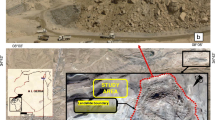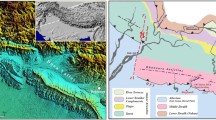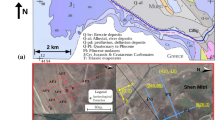Abstract
The Experimental Platform of Tournemire (Aveyron, France) developed by IRSN (French Institute for Radiological Protection and Nuclear Safety) is composed of a tunnel excavated in an argillite formation belonging to a limestone–argillite–limestone subhorizontal sedimentary sequence. Subvertical secondary fault zones were intercepted in argillite using drifts and boreholes in the tunnel excavated at a depth of about 250 m located under the Larzac Plateau. A 2D 2.5 km baseline large-scale electrical resistivity survey conducted in 2007 allowed detecting in the upper limestones several significantly low electrical resistivity subvertical zones (Gélis et al. Appl Geophys 167(11): 1405–1418, 2010). One of these discontinuities is consistent with the extension towards the surface of the secondary fault zones identified in the argillite formation from the tunnel. In an attempt to better characterize this zone, IRSN and MINES ParisTech conducted a high-resolution electrical resistivity survey located transversally to the fault and fracture zones. A 760-m-long profile was acquired using two array geometries and take-outs of 2, 4 and 8 m, requiring several roll-alongs. These data were first inverted independently for each take-out and then using all take-outs together for a given array geometry. Different inverted 2D electrical resistivity models display the same global features with high (higher than 5000 Ωm) to low (lower than 100 Ωm) electrical resistivity zones. These electrical resistivity models are finally compared with a geological cross-section based on independent data. The subvertical conductive zones are in agreement with the fault and fracture locations inferred from the geological cross-section. Moreover, the top of a more conductive zone, below a high electrical conductive zone and between two subvertical fault zones, is located in a more sandy and argillaceous layer. This conductive zone is interpreted as the presence of a more scattered fracture zone located at depth between two fault zones. This zone could be correlated with the fractured zones identified at 250-m depth in underground works. This study highlights the interest of multi-scale approaches to image complex heterogeneous near subsurface layers. Finally, this study shows that the electrical resistivity tomography is a useful and powerful tool to detect fault and fracture zones in upper limestones. Such a method is complementary to other geophysical and geological data.













Similar content being viewed by others
References
Binley, A. and Kemna, A. Dc resistivity and induced polarization methods. In: Hydrogeophysics. Springer; 2005. p. 129–156.
Boisson, J., Bertrand, L., Heitz, J. and Golvan, Y. (2001). In-situ and laboratory investigations of fluid flow through an argillaceous formation at different scales of space and time, Tournemire tunnel, Southern France. Hydrogeology Journal 9, 108–123.
Boisson, J., Cabrera, J. and de Windt, L. (1996). Investigation faults and fractures in an argillaceous formation at the IPSN Tournemire research site. In: Proc. OECD/NEA-E.C. International Workshop on Fluid Flow Through Faults and Fractures in Argillaceous Formation, Berne, 10–12 June
Bonin, B. (1998). Deep geological disposal in argillaceous formations: studies at the Tournemire test site. Journal of Contaminant Hydrology 35, 315–330.
Cabrera, J., Beaucaire, C., Bruno, G., de Windt, L., Genty, A., Ramambasoa, N., Rejeb, A., Savoye, S. and Volant, P. (2001). Projet Tournemire: synthèse des résultats des programmes de recherche 1995/1999. In: IRSN report.
Caputo, R., Piscitelli, S., Oliveto, A., Rizzo, E. and Lapenna, V. (2003). The use of electrical resistivity tomographies in active tectonics: examples from the Tyrnavos Basin, Greece. J. Geodyn. 36, 19–35.
Cosenza, P., Ghorbani, A., Florsch, N. and Revil, A. (2007). Effects of drying on the low-frequency electrical properties of Tournemire argilites. P. Appl. Geophys. 164, 2043–2066.
Dahlin, T. and Loke, M. (1998). Resolution of 2D Wenner resistivity imaging as assessed by numerical modelling. J. App. Geophys. 38, 237–249.
Dahlin, T. and Zhou, B. (2004). A numerical comparison of 2D resistivity imaging with 10 electrode arrays. Geophys. Prospect. 52, 379–398.
Demanet, D., Pirard, E., Renardy, F. and Jongmans, D. (2001). Application and processing of geophysical images for mapping faults. Computers and Geoscience 27, 1031–1037.
Frid, V., Liskevich, G., Doudkinski, D. and Korostishevsky, N. (2008). Evaluation of landfill disposal boundary by means of electrical resistivity imaging. Environmental Geology 53, 1503–1508.
Gélis C., Revil A., Cushing M. E., Jougnot D., Lemeille F., Cabrera J., De Hoyos A., Rocher M. (2010). Potential of Electrical Resistivity Tomography to Detect Fault Zones in Limestone and Argillaceous Formations in the Experimental Platform of Tournemire, France. P. Appl. Geophys, vol. 167, no. 11, pp. 1405–1418,
Gibert, D., Nicollin, F., Kergosien, B., Bossart, P., Nussbaum, C., Grislin-Mouëzy, A., Conil, F., Hoteit, N., 2006. Electrical tomography monitoring of the excavation damaged zone of the gallery 04 in the Mont Terri rock laboratory: Field experiments, modelling, and relationship with structural geology. Applied clay science; 33 (1) : 21–34.
Grandjean G., Hibert C., Mathieu F., Garel E. and Malet J.-F., 2009. Monitoring water-flow in a clay-shale hillslope from geophysical data fusion based on a fuzzy logic approach. C. R. Gesciences 341, 937–948.
Guérin, R., Munoz, M., Aran, C., Laperrelle, C., Hidra, M., Drouart, E. and Grellier, S. (2004). Leachate recirculation: moisture content assessment by means of a geophysical technique. Waste Management 24, 785–794.
Hamzah, U., Yaacup, R., Samsudin, A. and Ayub, M. (2006). Electrical imaging of the groundwater aquifer at Banting, Selangor, Malaysia. Environmental Geology 49, 1156–1162.
Improta L., Ferranti L., De Martini P.M., Piscitelli S., Bruno P.P., Burrato P., Civico R., Giocoli A., Iorio M., D’Addezio G. and Maschio L., 2010. Detecting young, slow-slipping active faults by geologic and multi-disciplinary high-resolution geophysical investigations : a case study for the Apennine seismic belt, Italy. J. Geophys. Res., 115, B11307.
Kruschwitz, S. and Yaramanci, U., 2004. Detection and characterization of the disturbed rock zone in claystone with complex resistivity method. Journal of Applied Geophysics 57, 63–79.
Leroy, P., Revil, A., Altmann, S. and Tournassat, C. (2007). Modeling the composition of the pore water in a clay-rock geological formation (Callovo-Oxfordian, France). Geochimica et Cosmochimica Acta 71 (5), 1087–1097.
Loke, M. and Barker, R. (1995). Least-squares deconvolution of apparent resistivity pseudosections. Geophysics 60 (6), 1682–1690.
Loke, M. and Barker, R. (1996). Rapid least-squares inversion of apparent resistivity pseudosections by a quasi-Newton method. Geophysical Prospecting 44, 131– 152.
Meric, O., Garambois, S., Jongmans, D., Wathelet, M., Chatelain, J. and Vengeon, J. (2005). Application of geophysical methods for the investigation of the large gravitational mass movement of Séchilienne, France. Can. Geotech. Journal 42, 1105–1115.
Nguyen F., S. Garambois, D. Chardon, D. Hermitte, O. Bellier and D. Jongmans (2007). Subsurface electrical imaging of anisotropic formations affected by a slow active reverse fault, Provence, France. Journal of Applied Geophysics 62, 338–353.
Nguyen F., Garambois S., Jongmans D., Pirard E. and Loke M.H. (2005). Image processing of 2D resistivity data for imaging faults. Journal of Applied Geophysics, 57, 260-277.
Penz S., Chauris H., Donno D. and Mehl C. (2013). Resistivity modelling with topography. Geophys. J. Int., 194, 1486–1497
Revil, A., Finizola, A., Piscitelli, A., Rizzo, E., Ricci, T., Crespy, A., Angeletti, B., Balasco, M., Barde Cabusson, S., Bennati, L., Bolève, A., Byrdina, S., Carzaniga, N., Di Gangi, F., Morin, J., Perrone, A., Rossi, M., Roulleau, E. and Suski, B. (2008). Inner structure of la Fossa di vulcano (vulcano island, southern Tyrrhenian Sea, Italy) revealed by high resolution electric resistivity tomography coupled with self-potential, temperature, and soil CO2 diffuse degassing measurements. Journal of Geophysical Research, 113, B07207, doi:10.1029/2007JB005394.
Rizzo, E., Colella, A., Lapenna, V. and Piscitelli, S. (2004). High-resolution images of the fault-controlled high Agri valley basin (Southern Italy) with deep and shallow resistivity tomographies. Physics and Chemistry of the Earth 29, 321–327.
Robert T., Dassargues A., Brouyère S., Kaufmann O., Hallet V. and Nguyen F., 2011. Assessing the contribution of electrical resistivity tomography (ERT) and self-potential (SP) methods for a water well drilling program in fractured/karstified limestones. Journal of Applied Geophysics 75, 42–53
Storz, H., Storz, W. and Jacobs, F. (2000). Electrical resistivity tomography to investigate geological structures of the earth’s upper crust. Geophysical Prospecting 48 (3), 455–471.
Suzuki, K., Toda, S., Kusunoki, K., Fujimitsu, Y., Mogi T., and Jomori, A. (2000). Case studies of electrical and electromagnetic methods applied to mapping active faults beneath the thick quaternary. Engineering Geology 56, 29–45.
Trouiller, A. (2006). The Callovo-Oxfordian of the Paris basin: from its geological context to the modelling of its properties. Comptes Rendus Geosciences, 338, 815–823.
Vanneste, K., Verbeeck, K. and Petermans, T. (2008). Pseudo-3D imaging of low-slip-rate, active normal fault using shallow geophysical methods: The Geleen fault in the Belgian Maas river valley. Geophysics 73 (1), B1–B9.
Vi Nhu Ba, E., Noble, M., Gélis, C., Gesret, A., & Cabrera, J. (2013). Geophysical imaging of near subsurface layers to detect fault and fractured zones in the Tournemire experimental Platform, France., in EGU General Assembly Conference Abstracts, vol. 15, p. 7783.
Yven, B., Sammartino, S., Géraud, Y., Homand and F., Villiéras (2007). Mineralogy, texture and porosity of Callovo-Oxfordian argillites of the Meuse/Haute-Marne region (eastern Paris basin). Bulletin de la Société Géologique de France 178, 73–90
Acknowledgments
The authors greatly thank the reviewers for their helpful comments and suggestions to improve this manuscript. The high-resolution electrical resistivity acquisitions were funded by the GNR TRASSE project IRSN-CNRS 2010-B. We are thankful for useful discussions with Hervé Jomard.
Author information
Authors and Affiliations
Corresponding author
Rights and permissions
About this article
Cite this article
Gélis, C., Noble, M., Cabrera, J. et al. Ability of High-Resolution Resistivity Tomography to Detect Fault and Fracture Zones: Application to the Tournemire Experimental Platform, France. Pure Appl. Geophys. 173, 573–589 (2016). https://doi.org/10.1007/s00024-015-1110-1
Received:
Revised:
Accepted:
Published:
Issue Date:
DOI: https://doi.org/10.1007/s00024-015-1110-1




